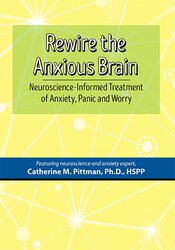Rewire the Anxious Brain: Neuroscience-Informed Treatment of Anxiety, Panic and Worry, 29/01/2021 00:00:00 South Africa Standard Time, Online Learning More info »

Rewire the Anxious Brain: Using Neuroscience to End Anxiety, Panic and Worry
Credit Available - See CEUs tab below.
- Categories:
- Anxiety | Neuroscience and Neuropsychology
- Faculty:
- Catherine Pittman, PhD, HSPP
- Duration:
- 5 Hours 39 Minutes
- Format:
- Audio and Video
- Original Program Date:
- 13 Mar, 2017
- SKU:
- POS051415
- Media Type:
- Online Learning - Also available: Online Learning
Description
- Apply proven brain-based strategies for Panic, Social Anxiety, OCD, GAD, and PTSD
- Understand the difference between cortex-based and amygdala-based anxiety
- Motivate clients and calm the anxious brain using the power of neuroplasticity
- Increase client engagement by focusing on changing the brain - not simply decreasing anxiety
Join neuroscience and anxiety expert, Dr. Catherine Pittman, and learn her keys for successful anxiety treatment. Dr. Pittman integrates brain-based strategies for calming the anxious mind with client communication techniques that motivate change in your clients. Catherine’s approach promotes adherence to treatment and strengthens the therapeutic alliance - which is essential when working with anxious, worried, traumatized, or obsessive clients.
Dr. Pittman will give you proven tools and techniques to:
- Identify and treat the roots of anxiety in both the amygdala and the cortex
- Explain “the language of the amygdala” in an accessible, straight forward way
- Identify how the cortex contributes to anxiety, and empower clients with strategies to resist anxiety-igniting cognitions
Therapy is about change - it’s about creating a new self - and incorporating the concept of “rewiring the brain” is a potent method for stopping anxiety in its tracks.
CEUs
This course is available for 5.75 total CPDs.
The HPCSA has declared that any on-line courses CPD/CEU credited by a certified US board, is automatically CPD/CEU credited in South Africa.
As there are different boards for different disciplines, we at Acacia suggest that you use the Counselling CPD/CEU credits. These correspond to South African credits of one CPD/CEU per 60 minutes. If you choose to use your discipline's credits, please do so at your discretion.
PESI, Inc. is an approved provider with the Florida Board of Clinical Social Work, Marriage and Family Therapy and Mental Health Counseling. Provider Number 50-399. This self-study course qualifies for 6.0 continuing education credits.
Handouts
| File type | File name | Number of pages | |
|---|---|---|---|
| Manual (1.97 MB) | 60 Pages | Available after Purchase |
Faculty

Catherine Pittman, PhD, HSPP Related seminars and products
Saint Mary's College
Catherine Pittman, PhD, HSPP, is a professor of psychology at Saint Mary’s College, Notre Dame, Indiana. Dr. Pittman is the author of the popular books Rewire the Anxious Brain: How to Use the Neuroscience of Fear to End Anxiety, Panic, and Worry (New Harbinger Publications) and Taming Your Amygdala (PESI Publishing & Media). She has a background in cognitive behavioral therapy, neuropsychology, fear-conditioning research, and has treated anxiety-based disorders in clinical practice for over 25 years.
Dr. Pittman’s experience makes her uniquely qualified to provide a clear understanding of neuroscience and how that informs the selection and application of successful anxiety treatment strategies. She is recognized for her clear, accessible explanations of the role of the amygdala, and her approaches to lifestyle change and cognitive restructuring that help motivate clients to be more engaged and motivated in therapy. Dr. Pittman regularly presents workshops at national conferences and webinars on anxiety treatment and is an active member of the public education committee of the Anxiety and Depression Association of America.
Speaker Disclosures:
Financial: Dr. Catherine Pittman has employment relationships with Saint Mary's College and Renew Counseling. She receives royalties as a published author. Dr. Pittman receives a speaking honorarium, recording, and book royalties from Psychotherapy Networker and PESI, Inc. She has no relevant financial relationships with ineligible organizations.
Non-financial: Dr. Catherine Pittman is a member of the Anxiety and Depression Association of America.
Alternate Options
|
Rewire the Anxious Brain: Neuroscience-Informed Treatment of Anxiety, Panic and Worry
Original Program Date: 29/01/2021 - SKU POS051415 |
Additional Info
Program Information
Access for Self-Study (Non-Interactive)Access never expires for this product.
Target Audience
Addiction Counselors, Counselors, Teachers/Educators, Marriage & Family Therapists, Nurses, Occupational Therapists & Occupational Therapy Assistants, Psychologists, Social Workers, Speech-Language Pathologists, and other Mental Health Professionals.Objectives
- Ascertain the underlying neurological processes that impact anxious symptoms for clients.
- Develop client engagement in treatment using personalized goals and attending to the therapeutic relationship.
- Evaluate the differences between amygdala-based and cortex-based anxiety symptoms and identify how these symptoms inform treatment interventions.
- Communicate strategies for calming and training the amygdala in order to alleviate symptoms of anxiety.
- Implement methods for teaching clients to retrain the cortex so that anxiety is resisted rather than exacerbated.
- Analyze how psychotropic medication impacts neuroplasticity in the brain; identify related treatment implications.
Outline
Use Neuroscience in the Treatment of Anxiety
- Positives: We know more about anxiety-based disorders than any other disorders
- Science gives explanations, evidence, authority, destigmatizes difficulties
- Concerns: It can be difficult to explain, answer questions
- Clients may feel a lack of responsibility
- Oversimplification is inevitable
Enhancing Engagement in Treatment
- Don’t neglect the therapeutic relationship!
- Address the challenges of anxious clients
- Remember that strategies are effortful
- Guide the process using client’s goals
- Maintain motivation
Neuroplasticity
- Define Neuroplasticity in everyday language
- Therapy is about creating a new self
- “Rewiring” as an accessible concept for change
- Re-consolidation: the modification of emotional memories
Identify Two Neural Pathways to Anxiety
- Amygdala – bottom-up triggering of emotion, physicality of anxiety
- Cortex – top-down emotion generation based in cognition
- Explain the two pathways to clients
- How anxiety is initiated in each pathway and how pathways influence each other
Client-Friendly Explanations
- Use illustrations to create concrete understanding
- Fight/flight/freeze responses
- The “language of the amygdala”
- Anxiety and the cortex
- Help clients recognize the two pathways to anxiety
Neuroplasticity in the Amygdala (Essential for all Anxiety Disorders, PTSD, OCD, Depression)
- Sleep and the amydgala
- The influence of exercise
- Breathing techniques to reduce activation
- Relaxation, meditation, and yoga to modify responses
- Exposure as opportunities for the amygdala to learn
- Combating avoidance
- When anxiety indicates that the amygdala can learn new responses
- Push through anxiety to change the amygdala
Neuroplasticity in the Cortex (Essential for GAD, SAD, OCD, PTSD, Depression)
- “Survival of the busiest” principle—strengthen or weaken specific circuitry
- The healthy (adaptive) use of worry in the cortex
- “You can’t erase: You must replace.”
- Recognize and modify the impact of uncertainty
- Training correct uses of distraction
- Left hemisphere techniques- cognitive defusion, coping thoughts, fighting anticipation
- Right hemisphere techniques – imagery, music
- Mindfulness and anxiety resistances
Neuroplasticity and Medications for Anxiety Disorders, OCD, PTSD, Depression
- Medication’s effects in the rewiring process
- The myth of the chemical imbalance
- The danger of sedating the brain with benzodiazepines
- Promoting neuroplasticity with SSRIs, SNRIs
- The effectiveness of CBT and meds
Moving Beyond Diagnostic Categories to Focus on Anxiety Pathways
- Anxiety is a component of many diagnoses (depression, substance abuse, etc.)
- Amygdala- and cortex-based techniques help in other disorders
- Targeting brain-based symptoms rather than disorders
- Worry, obsessions, rumination respond to similar cortex-based techniques
- Panic, phobic responses, and compulsions respond to amygdala-based techniques
Please wait ...
